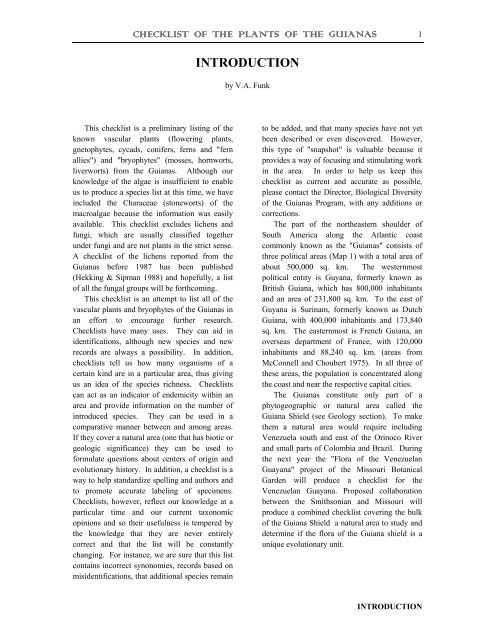Checklist of the Plants of the Guianas - Department of Botany ...
Checklist of the Plants of the Guianas - Department of Botany ...
Checklist of the Plants of the Guianas - Department of Botany ...
Create successful ePaper yourself
Turn your PDF publications into a flip-book with our unique Google optimized e-Paper software.
CHECKLIST OF THE PLANTS OF THE GUIANAS<br />
This checklist is a preliminary listing <strong>of</strong> <strong>the</strong><br />
known vascular plants (flowering plants,<br />
gnetophytes, cycads, conifers, ferns and "fern<br />
allies") and "bryophytes" (mosses, hornworts,<br />
liverworts) from <strong>the</strong> <strong>Guianas</strong>. Although our<br />
knowledge <strong>of</strong> <strong>the</strong> algae is insufficient to enable<br />
us to produce a species list at this time, we have<br />
included <strong>the</strong> Characeae (stoneworts) <strong>of</strong> <strong>the</strong><br />
macroalgae because <strong>the</strong> information was easily<br />
available. This checklist excludes lichens and<br />
fungi, which are usually classified toge<strong>the</strong>r<br />
under fungi and are not plants in <strong>the</strong> strict sense.<br />
A checklist <strong>of</strong> <strong>the</strong> lichens reported from <strong>the</strong><br />
<strong>Guianas</strong> before 1987 has been published<br />
(Hekking & Sipman 1988) and hopefully, a list<br />
<strong>of</strong> all <strong>the</strong> fungal groups will be forthcoming.<br />
This checklist is an attempt to list all <strong>of</strong> <strong>the</strong><br />
vascular plants and bryophytes <strong>of</strong> <strong>the</strong> <strong>Guianas</strong> in<br />
an effort to encourage fur<strong>the</strong>r research.<br />
<strong>Checklist</strong>s have many uses. They can aid in<br />
identifications, although new species and new<br />
records are always a possibility. In addition,<br />
checklists tell us how many organisms <strong>of</strong> a<br />
certain kind are in a particular area, thus giving<br />
us an idea <strong>of</strong> <strong>the</strong> species richness. <strong>Checklist</strong>s<br />
can act as an indicator <strong>of</strong> endemicity within an<br />
area and provide information on <strong>the</strong> number <strong>of</strong><br />
introduced species. They can be used in a<br />
comparative manner between and among areas.<br />
If <strong>the</strong>y cover a natural area (one that has biotic or<br />
geologic significance) <strong>the</strong>y can be used to<br />
formulate questions about centers <strong>of</strong> origin and<br />
evolutionary history. In addition, a checklist is a<br />
way to help standardize spelling and authors and<br />
to promote accurate labeling <strong>of</strong> specimens.<br />
<strong>Checklist</strong>s, however, reflect our knowledge at a<br />
particular time and our current taxonomic<br />
opinions and so <strong>the</strong>ir usefulness is tempered by<br />
<strong>the</strong> knowledge that <strong>the</strong>y are never entirely<br />
correct and that <strong>the</strong> list will be constantly<br />
changing. For instance, we are sure that this list<br />
contains incorrect synonomies, records based on<br />
misidentifications, that additional species remain<br />
INTRODUCTION<br />
by V.A. Funk<br />
to be added, and that many species have not yet<br />
been described or even discovered. However,<br />
this type <strong>of</strong> "snapshot" is valuable because it<br />
provides a way <strong>of</strong> focusing and stimulating work<br />
in <strong>the</strong> area. In order to help us keep this<br />
checklist as current and accurate as possible,<br />
please contact <strong>the</strong> Director, Biological Diversity<br />
<strong>of</strong> <strong>the</strong> <strong>Guianas</strong> Program, with any additions or<br />
corrections.<br />
The part <strong>of</strong> <strong>the</strong> nor<strong>the</strong>astern shoulder <strong>of</strong><br />
South America along <strong>the</strong> Atlantic coast<br />
commonly known as <strong>the</strong> "<strong>Guianas</strong>" consists <strong>of</strong><br />
three political areas (Map 1) with a total area <strong>of</strong><br />
about 500,000 sq. km. The westernmost<br />
political entity is Guyana, formerly known as<br />
British Guiana, which has 800,000 inhabitants<br />
and an area <strong>of</strong> 231,800 sq. km. To <strong>the</strong> east <strong>of</strong><br />
Guyana is Surinam, formerly known as Dutch<br />
Guiana, with 400,000 inhabitants and 173,840<br />
sq. km. The easternmost is French Guiana, an<br />
overseas department <strong>of</strong> France, with 120,000<br />
inhabitants and 88,240 sq. km. (areas from<br />
McConnell and Choubert 1975). In all three <strong>of</strong><br />
<strong>the</strong>se areas, <strong>the</strong> population is concentrated along<br />
<strong>the</strong> coast and near <strong>the</strong> respective capital cities.<br />
The <strong>Guianas</strong> constitute only part <strong>of</strong> a<br />
phytogeographic or natural area called <strong>the</strong><br />
Guiana Shield (see Geology section). To make<br />
<strong>the</strong>m a natural area would require including<br />
Venezuela south and east <strong>of</strong> <strong>the</strong> Orinoco River<br />
and small parts <strong>of</strong> Colombia and Brazil. During<br />
<strong>the</strong> next year <strong>the</strong> "Flora <strong>of</strong> <strong>the</strong> Venezuelan<br />
Guayana" project <strong>of</strong> <strong>the</strong> Missouri Botanical<br />
Garden will produce a checklist for <strong>the</strong><br />
Venezuelan Guayana. Proposed collaboration<br />
between <strong>the</strong> Smithsonian and Missouri will<br />
produce a combined checklist covering <strong>the</strong> bulk<br />
<strong>of</strong> <strong>the</strong> Guiana Shield a natural area to study and<br />
determine if <strong>the</strong> flora <strong>of</strong> <strong>the</strong> Guiana shield is a<br />
unique evolutionary unit.<br />
1<br />
INTRODUCTION

















